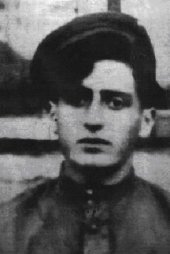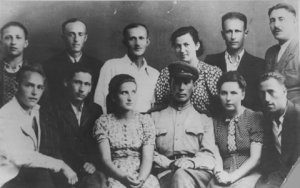 Philip
Bialowitz should have died 64 years ago. That he survived one day at
the Nazi death camp at Sobibór was mostly a matter of luck.
Philip
Bialowitz should have died 64 years ago. That he survived one day at
the Nazi death camp at Sobibór was mostly a matter of luck.
That he has lived this long is a testament to a group of people - himself included - who planned and executed one of two successful prisoner revolts against the Nazis during World War II.
Bialowitz, who now lives in New York, will be the featured speaker at two public events next week: the Yom HaShoah Holocaust remembrance on Sunday, April 15, at the Tri-City Jewish Center, and the Geifman Lecture in Holocaust Studies on Monday, April 16, at Augustana College.
On the April 1943 day that the 14-year-old Bialowitz was brought to the Sobibór (pronounced "SO-bee-bor") death camp in Poland with his brother, two sisters, and niece, the Germans were looking for replacement workers for the 50 Jews they'd killed the day before.
This was a stroke of relative good fortune for Bialowitz and his older brother, because Sobibór was an extermination camp, opened in May 1942 as part of the Operation Reinhard plan to kill 2 million Polish Jews. People were brought there and exterminated immediately. According to the United States Holocaust Memorial Museum's Holocaust Encyclopedia, the Germans and their auxiliaries killed at least 167,000 people at Sobibór; other estimates put the deaths at more than 250,000.
Because those numbers are dwarfed by the volume of deaths at camps such as Auschwitz, the Sobibór story is not well-known. "It was so overshadowed by the larger camps that it hasn't gotten the notoriety it justly deserves," said Allan Ross, executive director of the Jewish Federation of the Quad Cities.
"To tell the story about Sobibór can take volumes of books," Bialowitz said in a phone interview last week.
Sobibór survivor Thomas "Toivi" Blatt has written two books on the camp, one of which - along with another nonfiction work - served as the source material for the 1987 television movie Escape from Sobibór, featuring Alan Arkin and Rutger Hauer.
But the revolt remains a footnote to the Holocaust, and as a result, most of us have an incomplete sense of Jewish resistance. "The revolt of Sobibór will go in the annals of history, of the fighting spirit of the Jewish people - how we fought back," the 77-year-old Bialowitz said in his imperfect English. "My legacy is to tell the story, especially to young people."
Of his arrival at Sobibór in 1943, Bialowitz said, "They asked for professionals and tradespeople. My brother was a pharmacist. He raised his hand, and he grabbed my hand. He told the gestapo that I am his helper, his assistant. So my brother gave me the ... chance of life. My sisters and niece said goodbye. They knew they were going to die."
In the camp, one of Bialowitz's duties was to help move people from trains to the gas chambers. While many Jews who arrived at Sobibór understood that they were going to be killed, others were told that they were being brought in to work until the war was over.
 "The
Jews from Poland, they came in passenger cars with all their
belongings," Bialowitz said. "They were tricked. ... When they
arrived, and I helped them with their baggage, they even gave me a
tip for helping them with their baggage. My heart was bleeding. I
knew in a half an hour, they would be ashes."
"The
Jews from Poland, they came in passenger cars with all their
belongings," Bialowitz said. "They were tricked. ... When they
arrived, and I helped them with their baggage, they even gave me a
tip for helping them with their baggage. My heart was bleeding. I
knew in a half an hour, they would be ashes."
Officers perpetuated the ruse by encouraging the people to write to their families: "I would strongly recommend that you send home postcards to your dear ones," Bialowitz recalled them saying. "Some of them [the Jews] were clapping, and some of them were rushing for the postcards. They didn't know. Jews from Poland, they didn't realize that they were going to die."
The passengers were told they needed to shower because of typhus, and were led into a gas chamber.
The camp was in a remote area surrounded by mines and a forest. "If in the middle of the night, an animal stepped on a mine, they took us out ... to count us like diamonds," Bialowitz said. "They want that nobody should escape from Sobibór."
The plan to revolt against their captors began to take shape in mid-1943, led by Leon Feldhendler, a rabbi's son. "He was architect of the uprising," Bialowitz said. "He made the plan, but he didn't have any military know-how to execute the plan."
Bialowitz said that the next event was a "miracle." A transport of Russian Jewish POWs arrived at the camp, and about 80 people were enlisted to help with the operations at Sobibór. "This is the people we needed to help us with military," he said. "Because we didn't have any military experience. We never fought before."
Feldhendler made contact with Lieutenant Aleksandr "Sasha" Aronovich Pechersky and recruited him, Bialowitz said: "He became the leader of the military part."
One day before uprising, Bialowitz's brother gave him a bottle of cyanide and a compass. "He said in case I get injured from the mines, I should try to drink the poison so I should die in peace. And the compass was to show me how to go east to my town."
Bialowitz said that most of the people who planned the revolt had no expectation that they would live. They hoped that a handful of prisoners might make it, to tell the rest of the world about this secret death camp. "Maybe somebody will get out from Sobibór to tell the world what had happened here," he said. "But we didn't have anything to lose."
The plan was executed on October 14, 1943, and Bialowitz served as a messenger. "I had to call some of the gestapo to come to try on some boots, some leather coats," he said.
On his Web site (http://www.sobibor.info), survivor Blatt relates the story of the revolt with dispassionate precision: "At 4:l5 [p.m.], Oberscharfuehrer Graetschus, the German in charge of the Ukrainian guards, arrived at the cobblers' shop to pick up his order. While Yitzhak held the Nazi's leg in a firm grip, pretending to pull the boots, Arcady Wajspaper and Siemion Rosenfeld slipped out from the back room and split the skull of the Nazi with the ax."
 In
all, Bialowitz said, those involved with the revolt killed 11 Germans
and three Ukrainians with knives and axes. The plan to leave through
the camp's front gate was scratched when one of the bodies was
discovered. Although roughly half of the 600 prisoners escaped from
the camp that day, approximately 100 of those were killed in the
dragnet that followed.
In
all, Bialowitz said, those involved with the revolt killed 11 Germans
and three Ukrainians with knives and axes. The plan to leave through
the camp's front gate was scratched when one of the bodies was
discovered. Although roughly half of the 600 prisoners escaped from
the camp that day, approximately 100 of those were killed in the
dragnet that followed.
"I was very lucky that I find my brother in the woods" following the revolt, Bialowitz said. The two stayed in hiding for a year, he said.
After the rebellion, the Germans shut down the death camp.
About 50 prisoners who escaped from Sobibór survived the war, and Bialowitz said he's one of eight still living. Bialowitz's brother now lives in Israel. He is 96 years old and in poor health, his younger brother said.
Bialowitz came to the United States in 1950, spending three years in Ohio before moving to New York, working as a dental assistant and as a jeweler.
He has only begun to speak about his experience in Sobibór in the past five years, he said. "Before, I couldn't speak too much about it, because it was very difficult for me to go through all the experiences. But I came to the conclusion that we must tell the heroic uprising of Sobibór."
He quoted from the speech he plans to give in the Quad Cities, suggesting that it's his duty to educate people about the Holocaust, and to relate it to what's going on in the world today. Genocide is still happening, he said, in places such as Darfur. "My survival means very little," he said. "I helped to destroy the Sobibór Germans. But others have built new Sobibórs."
Yom HaShoah, the Quad Cities Holocaust Remembrance, will be held at 7 p.m. on Sunday, April 15, at the Tri-City Jewish Center, 2715 30th Street in Rock Island.
Bialowitz will also deliver the 2007 Geifman Lecture in Holocaust Studies at 7 p.m. on Monday, April 16, at Augustana College's Wallenberg Hall, inside Denkmann Memorial Building at 3250 Seventh Avenue in Rock Island.
The 1987 television movie Escape from Sobibór will be shown at 7:30 p.m. on Wednesday, April 11, at Temple Emanuel, 1115 Mississippi Avenue in Davenport.
Bialowitz's Web site can be found at (http://www.sobiborholocaustsurvivor.org). More information on the Sobibór revolt can be found at (http://www.ushmm.org/wlc/en/index.php?ModuleId=10005192).










